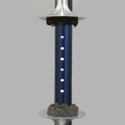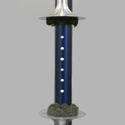A floating apothecary
In an effort to make medicinal drugs that dissolve more quickly on delivery, scientists at Argonne National Laboratory in Illinois are using the technique of acoustic levitation to prepare molecular gels and amorphous solids. The technique could prove important for preparing several drugs that are known to be insoluble in crystalline form.
Acoustic levitation uses the pressure from intense sound waves to suspend an object. The technique is widely used in microgravity experiments, but also provides a way to solidify the atoms or molecules in a liquid without the potentially contaminating effects of a container. In a paper published in the inaugural issue of the open-access journal Physical Review X, Chris Benmore and Richard Weber show this containerless method allows them to supercool liquid forms of several over-the-counter and prescription drugs into amorphous forms.
Benmore and Weber are able to form the amorphous solids in two different ways. Drugs such as ibuprofen (an anti-inflammatory) and clofoctol (an antibiotic) were first dissolved in ethanol and then droplets of the solution were allowed to evaporate while suspended in the levitator. In an alternative method, which works for the antihistamine cinnarizine, the team starts with a solid form of the drug, melts it into droplets with a laser and then suspends these droplets as they cool.
For now, these experiments are “proof of principle,” as the effectiveness and shelf life of the drugs in their new structural forms remain to be explored. – Jessica Thomas





